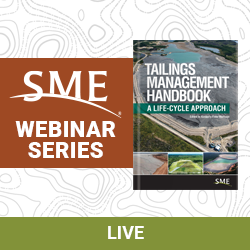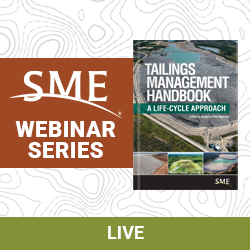Continue your career development and receive job-critical information when you attend an SME webinar.
Our hour-long technical sessions are designed for dedicated professionals like you. Industry leaders deliver timely and engaging professional development opportunities that fit your schedule.
A Universal Roadmap to Performing TDBAs
A Holistic Overview of the Cyanide Detoxification Process
Tailings Emergency Preparedness & Response Planning
Complimentary Test Webinar

MEETING DETAILS:
Location: Live Webcast
Starts: 11/28/2025 2:00:00 PM MT
Ends: 11/28/2025 3:00:00 PM MT
A Universal Roadmap to Performing TDBAs
PRICE:
Accurately modeling a tailings storage facility (TSF) breach is complicated due to the magnitude of uncertainties associated with the modeling parameters. Currently, there are no industry technical standards for developing the embankment breach parameters during a tailings breach assessment (TBA), and the typically referenced equations used to estimate embankment breach parameters are, in most cases, empirical (DSO 1998) and largely based on past failures of water-retaining dams less than 30 m high—which is not particularly applicable to large TSFs or TSFs in general.
Because of the complexities of a TSF embankment breach study and the inherent subjectivity on how to consider this process, a simplified approach is typically employed by most practitioners. The framework of which is generally based on four pillars:
As every TSF is unique, employing a one-size-fits-all approach for each of the four pillars results in an inaccurate characterization, or biasness, of many TSFs, based on contradictive assumptions. To limit this bias, it is important to use a framework that seeks to manifest logical connections between the four tailings dam breach assessment pillars.
This presentation discusses the four main pillars of a tailings dam breach analysis (TDBA) and how they can be leveraged universally across all TDBAs.

MEETING DETAILS:
Location: Live Webcast
Starts: 1/18/2026 10:00:00 AM MT
Ends: 1/18/2026 11:00:00 AM MT
A Holistic Overview of the Cyanide Detoxification Process
PRICE:
The SO2/Air cyanide detoxification process was developed when the usual requirements were based on a relatively steady concentration of weak acid dissociable cyanide (WAD CN-) in the feed of 150 to 200 mg/L and a discharge limit of less than 50 mg/L. However, as more metallurgically complex deposits are developed, and environmental regulations become stricter, cyanide destruction demands have evolved and become more stringent. Nowadays, discharge limits below 1 mg/L WAD CN- are not uncommon, and the SO2/Air process often needs to treat feeds containing more than 600 mg/L of WAD CN-. Adding further complexity is that solutions containing elevated levels of thiocyanate (SCN-) and/or thiosalts are becoming commonplace and can negatively impact the ability to recycle process water and the capability to achieve overall site environmental compliance. This paper provides a holistic overview of the SO2/Air process, interconnections between metallurgical and environmental issues, including carbon footprint reduction and sustainability, and discusses changes in design and operations strategies needed to meet the requirements of modern gold extraction projects.

MEETING DETAILS:
Location: Live Webcast
Starts: 1/25/2026 10:00:00 AM MT
Ends: 1/25/2026 11:00:00 AM MT
Tailings Emergency Preparedness & Response Planning
PRICE:
There have been notable tailings failures throughout the world that resulted in catastrophic consequences. While it is a mining operator’s primary goal to prevent tailings failures, it is also imperative to be prepared should such an event occur. The actions taken in the initial minutes, hours, and days of a tailings emergency are critical in preventing harm to people and the environment. A well-designed strategy for emergency preparedness and response planning can enhance the ability to respond effectively and efficiently to an emergency and reduce the potential for unimaginable loss. This webinar will reiterate the importance of an Emergency Preparedness and Response Plan and highlight key considerations for plan development.

MEETING DETAILS:
Location: Live Webcast
Starts: 1/25/2026 10:00:00 AM MT
Ends: 1/25/2026 11:00:00 AM MT
Complimentary Test Webinar
PRICE:
There have been notable tailings failures throughout the world that resulted in catastrophic consequences. While it is a mining operator’s primary goal to prevent tailings failures, it is also imperative to be prepared should such an event occur. The actions taken in the initial minutes, hours, and days of a tailings emergency are critical in preventing harm to people and the environment. A well-designed strategy for emergency preparedness and response planning can enhance the ability to respond effectively and efficiently to an emergency and reduce the potential for unimaginable loss. This webinar will reiterate the importance of an Emergency Preparedness and Response Plan and highlight key considerations for plan development.

A Universal Roadmap to Performing TDBAs
PRICE:
Accurately modeling a tailings storage facility (TSF) breach is complicated due to the magnitude of uncertainties associated with the modeling parameters. Currently, there are no industry technical standards for developing the embankment breach parameters during a tailings breach assessment (TBA), and the typically referenced equations used to estimate embankment breach parameters are, in most cases, empirical (DSO 1998) and largely based on past failures of water-retaining dams less than 30 m high—which is not particularly applicable to large TSFs or TSFs in general.
Because of the complexities of a TSF embankment breach study and the inherent subjectivity on how to consider this process, a simplified approach is typically employed by most practitioners. The framework of which is generally based on four pillars:
As every TSF is unique, employing a one-size-fits-all approach for each of the four pillars results in an inaccurate characterization, or biasness, of many TSFs, based on contradictive assumptions. To limit this bias, it is important to use a framework that seeks to manifest logical connections between the four tailings dam breach assessment pillars.
This presentation discusses the four main pillars of a tailings dam breach analysis (TDBA) and how they can be leveraged universally across all TDBAs.
MEETING DETAILS:
Location: Live Webcast
Starts: 11/28/2025 2:00:00 PM MT
Ends: 11/28/2025 3:00:00 PM MT

A Holistic Overview of the Cyanide Detoxification Process
PRICE:
The SO2/Air cyanide detoxification process was developed when the usual requirements were based on a relatively steady concentration of weak acid dissociable cyanide (WAD CN-) in the feed of 150 to 200 mg/L and a discharge limit of less than 50 mg/L. However, as more metallurgically complex deposits are developed, and environmental regulations become stricter, cyanide destruction demands have evolved and become more stringent. Nowadays, discharge limits below 1 mg/L WAD CN- are not uncommon, and the SO2/Air process often needs to treat feeds containing more than 600 mg/L of WAD CN-. Adding further complexity is that solutions containing elevated levels of thiocyanate (SCN-) and/or thiosalts are becoming commonplace and can negatively impact the ability to recycle process water and the capability to achieve overall site environmental compliance. This paper provides a holistic overview of the SO2/Air process, interconnections between metallurgical and environmental issues, including carbon footprint reduction and sustainability, and discusses changes in design and operations strategies needed to meet the requirements of modern gold extraction projects.
MEETING DETAILS:
Location: Live Webcast
Starts: 1/18/2026 10:00:00 AM MT
Ends: 1/18/2026 11:00:00 AM MT

Tailings Emergency Preparedness & Response Planning
PRICE:
There have been notable tailings failures throughout the world that resulted in catastrophic consequences. While it is a mining operator’s primary goal to prevent tailings failures, it is also imperative to be prepared should such an event occur. The actions taken in the initial minutes, hours, and days of a tailings emergency are critical in preventing harm to people and the environment. A well-designed strategy for emergency preparedness and response planning can enhance the ability to respond effectively and efficiently to an emergency and reduce the potential for unimaginable loss. This webinar will reiterate the importance of an Emergency Preparedness and Response Plan and highlight key considerations for plan development.
MEETING DETAILS:
Location: Live Webcast
Starts: 1/25/2026 10:00:00 AM MT
Ends: 1/25/2026 11:00:00 AM MT

Complimentary Test Webinar
PRICE:
There have been notable tailings failures throughout the world that resulted in catastrophic consequences. While it is a mining operator’s primary goal to prevent tailings failures, it is also imperative to be prepared should such an event occur. The actions taken in the initial minutes, hours, and days of a tailings emergency are critical in preventing harm to people and the environment. A well-designed strategy for emergency preparedness and response planning can enhance the ability to respond effectively and efficiently to an emergency and reduce the potential for unimaginable loss. This webinar will reiterate the importance of an Emergency Preparedness and Response Plan and highlight key considerations for plan development.
MEETING DETAILS:
Location: Live Webcast
Starts: 1/25/2026 10:00:00 AM MT
Ends: 1/25/2026 11:00:00 AM MT
